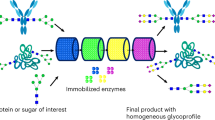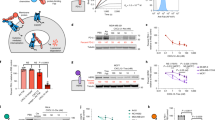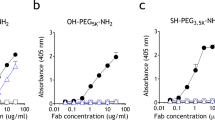Abstract
We have modified recombinant interleukin-2 (rIL-2) to facilitate site-directed covalent attachment of monomethoxy polyethylene glycol (PEG). The site chosen for modification and subsequent covalent attachment with PEG (PEGylation) was the single glycosylation position found in the native interleukin-2 (IL-2). The mutant protein was expressed in E. coli, purified, and PEGylated with a PEG-maleimide reagent to obtain PEG-cys3-rIL-2. The PEG-cys3-rIL-2 had full bioactivity relative to the unmodified molecule and had an increase in hydrodynamic size sufficient to increase its systemic exposure by ∼4 fold. This method has general applicability for modifying any therapeutic protein at a specific site and thereby alter its potency. In particular, it can be used to attach PEG to prokaryotically expressed recombinant proteins at their glycosylation sites.
This is a preview of subscription content, access via your institution
Access options
Subscribe to this journal
Receive 12 print issues and online access
$209.00 per year
only $17.42 per issue
Buy this article
- Purchase on Springer Link
- Instant access to full article PDF
Prices may be subject to local taxes which are calculated during checkout
Similar content being viewed by others
References
Robb, R.J. 1985. Human interleukin-2. Methods in Enzymol 116: 493–525.
Smith, K.A., 1988. Interleukin-2: Inception, impact, and implications. Science 240: 1169–1176.
Hadden, J.W. 1988. Recent advances in preclinical and clinical immunopharmacology of interleukin-2. Cancer Detect. Prev. 12: 537–552.
Robb, R.J., Kutny, R.M., Panico, M. et al. 1984. Amino acid sequence and post-translational modification of human interleukin-2. Proc. Natl. Acad. Sci. USA 81: 6486–6490.
Wang, A., Lu, S.-D., Mark, D.F. 1984. Site-specific mutagenesis of human interleukin-2 gene: Structure-function analysis of cysteine residues. Science 224: 1431–1433.
Matsui, H., Fujita, T., Nishi-Takaoka, C. et al. 1985. Molecular cloning and expression of human interleukin-2 gene. Lymphokines 12: 1–12.
Rosenberg, S.A., Grimm, E.A., McGrogan, M. et al. 1984. Biological activity of recombinant human interleukin-2 produced in Escherichia coli . Science 233: 1412–1415.
Katre, N.V., Knauf, M.J. and Laird, W.J. 1987. Chemical modification of recombinant interleukin 2 by polyethylene glycol increases its potency in the murine Meth A sarcoma model. Proc. Natl. Acad. Sci. USA 84: 1487–1491.
Knauf, M.J., Bell, D.P., Hirtzer, P., Luo, Z.-P., Young, J.D. and Katre, N.V. 1988. Relationship of effective molecular size to systemic clearance in rats of recombinant interleukin-2 chemically modified with water-soluble polymers. J. Biol. Chem. 263: 15064–15070.
Zimmerman, R.J., Aukerman, S.L., Katre, N.V. et al. 1989. Schedule dependency of antitumor activity and toxicity of PEG-modified IL-2 in murine tumor models. Cancer Res. 49: 6521–6528.
Davis, F.F., Abuchowski, A., Van Es, T. et al. 1980. Soluble, nonanti-genic polyethylene glycol-bound enzymes. Biomedical Polymers, p. 441. Academic Press, N.Y.
Lisi, P.J., Van Es, T., Abuchowski, A. et al. 1982. Enzyme therapy. J. Applied Biochem. 4: 19–33.
Beauchamp, C.O., Gonias, S.L., Menapace, D.P. et al. 1982. A new procedure for synthesis of polyethylene glycol-protein adducts. Anal. Biochem. 131: 25–33.
Abuchowski, A., Kazo, G.M., Verhoest, C.R. et al. 1984. Cancer therapy with chemically modified enzymes. Cancer Biochem. Biophys. 7: 175–186.
Means, G.E. and Feeney, R.E. 1971. Chemical Modification of Proteins, p. 219, Holden Day, Inc.
Kramer, W., Drutsa, V., Jansen, H.-W. et al. 1984. Gapped duplex DNA approach to oligonucleotide-directed mutation construction. Nucleic Acids Res. 12: 9441–9456.
Carter, P., Bedouelle, H. and Winter, G. 1985. Improved oligonucleotide site-directed mutagenesis using M 13 vectors. Nucleic Acids Res. 13: 4431–4443.
Ausubel, F.M., Brent, R., Kingston, R.E. et al. 1987. Current Protocols in Molecular Biology, Vol. 1, Section 3.16.1 John Wiley, NY.
Ausubel, F.M., Brent, R., Kingston, R.E. et al. 1987. Current Protocols in Molecular Biology, Vol. 1, Section 3.5.10 John Wiley, NY.
Hanahan, D. 1983. Studies on transformation of Escherichia coli with plasmids. J. Mol. Biol. 166: 557–580.
Zoller, M.J. and Smith, M. 1983. Oligonucleotide-directed mutagenesis of DNA fragments cloned into M 13 Vectors. Methods in Enzymol. 100: 468–500.
Greenfield, L., Dovey, H.F., Lawyer, F.C. et al. 1986. High Level expression of diphtheria toxin peptides in Escherichia coli . Bio/Technology 4: 1006–1011.
Cole, G.E., McCabe, P.C., Inlow, D. et al. 1988. Stable expression of Aspergillus awamori glucoamylase in distiller's yeast. Bio/Technology 6: 417–421.
Dorin, G., Hanisch, W.H., Lin, L.S. 1988. Process for recovering refractile bodies containing heterologous proteins from microbial hosts. United States Patent ♯4,748,234.
Pillai, V.N.R. and Mutter, M., 1980. New, easily removable polyethylene glycol supports for liquid phase method of peptide synthesis. J. Org. Chem. 45: 5364–5367.
Aldwin, L. and Nitecki, D. 1987. A water-soluble, monitorable peptide and protein crosslinking agent. Anal. Biochem. 164: 494–501.
Tada, H., Shiho, O., Kuroshima, K. et al. 1986. An improved colorimetric assay for Interleukin-2. J. Immuno. Methods 93: 157–165.
Katre, N.V. 1990. Immunogenicity of recombinant IL-2 modified by covalent attachment of polyethylene glycol. J. Immunology 144: 209–213.
Author information
Authors and Affiliations
Rights and permissions
About this article
Cite this article
Goodson, R., Katre, N. Site-Directed Pegylation of Recombinant Interleukin-2 at its Glycosylation Site. Nat Biotechnol 8, 343–346 (1990). https://doi.org/10.1038/nbt0490-343
Issue Date:
DOI: https://doi.org/10.1038/nbt0490-343
This article is cited by
-
Formulation and Characterisation of Antibody-Conjugated Soy Protein Nanoparticles—Implications for Neutralisation of Snake Venom with Improved Efficiency
Applied Biochemistry and Biotechnology (2014)
-
Pegylated derivatives of recombinant human arginase (rhArg1) for sustained in vivo activity in cancer therapy: preparation, characterization and analysis of their pharmacodynamics in vivo and in vitro and action upon hepatocellular carcinoma cell (HCC)
Cancer Cell International (2009)
-
New Technologies to Prolong Life-time of Peptide and Protein Drugs In vivo
International Journal of Peptide Research and Therapeutics (2007)



